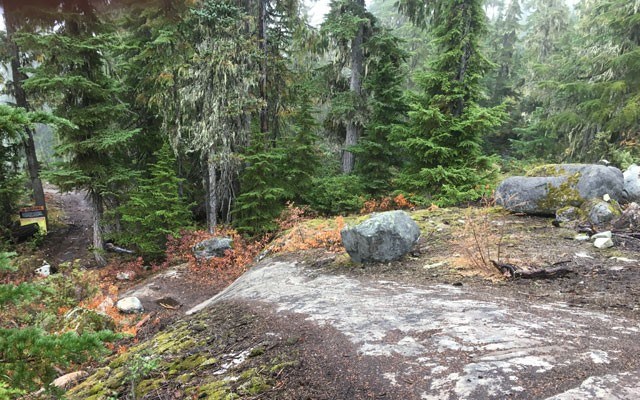When Scott Veach and Ben Haggar built Dark Crystal in the summer of 2015, one of their main aims was to create something that would be a beautiful part of the Whistler cycling scene for decades to come.
"It was just to get an aesthetic, photogenic trail. We just wanted to keep everything really neat and just get something that is a little more tame than the stuff in the valley, but there's bang for your buck with the climbing compared to the fun downhill," Veach said. "We both wanted it to have a lot of longevity so we wanted it to have a lot of low-angle lines that utilize the terrain as much as possible."
Inspired by trails like Khyber Pass, the pair spent much of that summer building before returning in 2016 to complete a few remaining features.
"Ben and I both really like slabs and big rock faces so we tried to target as many of those as possible without having any unnecessary climbs," Veach said. "We wanted to create a trail where you could take your hands off the brakes. That's a feature for us, where you can hit the fall line without pedalling or hitting the brakes."
After searching for the ideal spot, looking not only for just the right features but practical locations that weren't soon to be logged or worked on by other builders, they eventually found it on Blackcomb Mountain and started work, but they didn't realize it was part of Whistler Blackcomb's (WB) property.
Veach, a native Californian, said he knew to steer clear of the Whistler Mountain Bike Park, but wasn't otherwise sure of the jurisdiction governing where he was building.
"Now that I know, we should have tried to work with the local organizations like WORCA and WB a lot closer. They would have been really helpful," he said. "It would have cut out a lot of unnecessary headaches."
As of Friday, Sept. 22, the trail will officially be incorporated as part of WB's Blackcomb trail network.
WB vice-president of business development Rob McSkimming said it's a difficult balancing act at times to recognize that though some of these trails are being built without going through the official processes, the builders are putting together solid, creative lines and contributing to biking in the resort. That said, though, he stressed that it's crucial for builders to go through the official processes, as others in the future won't see their creations, no matter how interesting or well-built, live on.
"On our property, it's a little different than on Crown land or on other land jurisdictions. For us, in our CRA or Controlled Recreation Area, it's a relationship we have with the province and the mountain resort branch (MRB) of the province, which is different than the jurisdiction that manages Crown land," he said. "One of our obligations with the province is to say, 'This is what we're going to be doing on the mountain.' We are responsible for managing the property from a use standpoint, from an environmental standpoint, so when these things happen without our knowledge or permission, it causes some challenges for us and our relationship with the MRB."
WB, now owned by Vail Resorts, is requesting builders with ideas for trails on its property to reach out with a plan at [email protected]. While WB is still finalizing the information it will require in the proposals, McSkimming said the applications will be modelled after Section 57 of the Forest and Range Practices Act, which outlines how to apply to build trails on Crown land.
"We will require GPS coordinates. What type of trail do you want to build? What's your background? What kinds of trail work have you done? What kind of environmental standards do you plan to build the trail to?" he said, adding further details of the trail such as intended features would be of use as well.
Plans to maintain the trail are also helpful, he stressed.
While there wouldn't be a hard number of proposed trails that could be approved in a given time period, "you want to be respectful of what the forest can manage," McSkimming said.
The challenges for WB began about four or five years ago, McSkimming said, when it realized it had a number of illegal trails on its property that were gradually being used more and more by local riders. At that time, they sought to work with the province to authorize several of them, both on Blackcomb and on Whistler near Creekside. Though some were up to standard, McSkimming said, WB worked to upgrade others to WORCA's standard.




